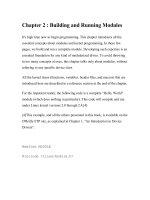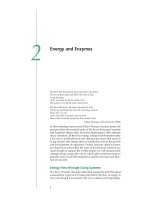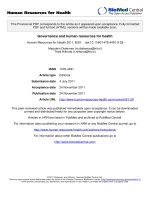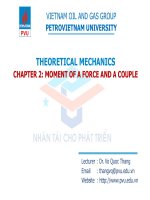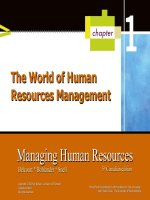HRM 5th chapter 2 strategy and human resources planning
Bạn đang xem bản rút gọn của tài liệu. Xem và tải ngay bản đầy đủ của tài liệu tại đây (1.06 MB, 44 trang )
Strategy and Human
Resources Planning
Managing Human Resources
Belcourt * Bohlander * Snell
5th Canadian edition
PowerPoint Presentation by
© 2008 by Nelson, a division of Thomson Canada
Limited
All rights reserved
Monica Belcourt, York University, and
Charlie Cook, The University of West Alabama
Objectives
After studying this chapter, you should be able to:
1.
Identify the advantages of integrating human resources
planning and strategic planning.
2.
Understand how an organization’s competitive environment
influences strategic planning.
3.
Recognize the importance of internal resource analysis.
4.
Describe the basic tools for human resources forecasting.
5.
Explain the linkages between competitive strategies and HR.
6.
Understand the requirements of strategy implementation.
7.
Recognize the methods for assessing and measuring the
effectiveness of strategy.
Copyright © 2008 by Nelson, a
2–2
Strategic Planning and Human Resources
• Strategic Planning
Procedures for making decisions about the
organization’s long-term goals and strategies
• Human Resources Planning (HRP)
Process of anticipating and making provision for the
movement (flow) of people into, within, and out of an
organization.
Copyright © 2008 by Nelson, a
2–3
Strategic Planning and HR Planning
• Strategic Human Resources Management (SHRM)
The pattern of human resources deployments and
activities that enable an organization to achieve its
strategic goals
Strategy formulation—providing input as to what is
possible given the types and numbers of people
available.
Strategy implementation—making primary resource
allocation decisions about structure, processes, and
human resources.
Copyright © 2008 by Nelson, a
2–4
HRP and Strategic Planning
• Strategic Analysis
What human resources are needed and what are
available?
• Strategic Formulation
What is required and necessary in support of human
resources?
• Strategic Implementation
How will the human resources be allocated?
Human
HumanResources
Resources
Planning
Planning
Copyright © 2008 by Nelson, a
Strategic
Strategic
Planning
Planning
2–5
Linking Strategic Planning and Human Resources
Figure 2.1
Copyright © 2008 by Nelson, a
2–6
Step One: Mission, Vision, and Values
• Mission
The basic purpose of the organization as well as its
scope of operations.
• Strategic Vision
A statement about where the company is going and
what it can become in the future; clarifies the longterm direction of the company and its strategic intent.
• Core Values
The strong and enduring beliefs and principles that
the company uses as a foundation for its decisions.
Copyright © 2008 by Nelson, a
2–7
Step Two: Environmental Analysis
• Environmental Analysis
The systematic monitoring of the major external
forces influencing the organization
1.
Economic factors: general and regional conditions
2.
Competitive trends: new processes, services, and
innovations
3.
Technological changes: robotics and office automation
4.
Political and legislative issues: laws and administrative
rulings
5.
Social concerns: child care and educational priorities
6.
Demographic trends: age, composition,and literacy
Copyright © 2008 by Nelson, a
2–8
Five Forces Framework
Figure 2.2
Copyright © 2008 by Nelson, a
2–9
Step Three: Internal Analysis
Culture
Competencies
Internal
Analysis
Composition
Copyright © 2008 by Nelson, a
2–10
Scanning the Internal Environment
• Cultural Audits
Audits of the culture and quality of work life in an
organization.
How do employees spend their time?
How do they interact with each other?
Are employees empowered?
What is the predominant leadership style of
managers?
How do employees advance within the
organization?
Copyright © 2008 by Nelson, a
2–11
Competitive Advantage through People
• Core Competencies
Integrated knowledge sets within an organization
that distinguish it from its competitors and deliver
value to customers.
• Sustained competitive advantage through people is
achieved if these human resources:
1. Are valuable
2. Are rare and unavailable to competitors
3. Are difficult to imitate
4. Are organized for synergy
Copyright © 2008 by Nelson, a
2–12
Composition: The Human Capital
Architecture
• Core knowledge workers
Employees who have firm-specific skills that are
directly linked to the company’s strategy.
Example: Senior software programmer
• Traditional job-based employees
Employees with skills to perform a predefined job that
are quite valuable to a company, but not unique.
Example: Security guard
Copyright © 2008 by Nelson, a
2–13
Composition: The Human Capital
Architecture (cont’d)
• Contract labour
Employees whose skills are of less strategic value
and generally available to all firms.
Example: General electrician
• Alliance/partners
Individuals and groups with unique skills, but those
skills are not directly related to a company’s core
strategy.
Example: Independent product label designer
Copyright © 2008 by Nelson, a
2–14
Mapping Human Capital
Figure 2.3
Copyright © 2008 by Nelson, a
2–15
Forecasting: A Critical Element of Planning
• Forecasting involves:
a. forecasting the demand for labour
b. forecasting the supply of labour
c. balancing supply and demand considerations
Copyright © 2008 by Nelson, a
2–16
Model of HR Forecasting
FORECASTING
FORECASTINGDEMAND
DEMAND
Considerations
Considerations
• •Product/service
Product/servicedemand
demand
• •Technology
Technology
• •Financial
Financialresources
resources
• •Absenteeism/turnover
Absenteeism/turnover
• •Organizational
Organizationalgrowth
growth
• •Management
philosophy
Management philosophy
Techniques
Techniques
• •Staffing
Staffingtables
tables
• •Markov
Markovanalysis
analysis
• •Skills
inventories
Skills inventories
• •Management
Managementinventories
inventories
• •Replacement
charts
Replacement charts
• •Succession
Successionplanning
planning
Techniques
Techniques
• •Trend
Trendanalysis
analysis
• •Managerial
Managerialestimates
estimates
• •Delphi
technique
Delphi technique
External
ExternalConsiderations
Considerations
• •Demographic
Demographicchanges
changes
• •Education
Educationof
ofthe
theworkforce
workforce
• •Labour
mobility
Labour mobility
• •Government
Governmentpolicies
policies
• •Unemployment
Unemploymentrate
rate
FORECASTING
FORECASTINGSUPPLY
SUPPLY
Copyright © 2008 by Nelson, a
BALANCING
BALANCING
SUPPLY
SUPPLYAND
AND
DEMAND
DEMAND
(Shortage)
(Shortage)
Recruitment
Recruitment
• •Full-time
Full-time
• •Part-time
Part-time
• •Recalls
Recalls
(Surplus)
(Surplus)
Reductions
Reductions
• •Layoffs
Layoffs
• •Terminations
Terminations
• •Demotions
Demotions
• •Retirements
Retirements
Figure 2.4
2–17
Forecasting Demand for Employees
Quantitative
QuantitativeMethods
Methods
Forecasting
Forecasting Demand
Demand
Qualitative
QualitativeMethods
Methods
Copyright © 2008 by Nelson, a
2–18
Quantitative Approach: Trend Analysis
• Forecasting labour demand based on an organizational
index such as sales:
1. Select a business factor that best predicts human
resources needs.
2. Plot the business factor in relation to the number of
employees to determine the labour productivity ratio.
3. Compute the productivity ratio for the past five years.
4. Calculate human resources demand by multiplying
the business factor by the productivity ratio.
5. Project human resources demand out to the target
year(s).
Copyright © 2008 by Nelson, a
2–19
Example of Trend Analysis of HR Demand
BUSINESS
FACTOR
YEAR
÷
(SALES IN THOUSANDS)
LABOUR
PRODUCTIVITY
(SALES/EMPLOYEE)
=
HUMAN RESOURCES
DEMAND
(NUMBER OF EMPLOYEES)
2000
$2,351
14.33
164
2001
$2,613
11.12
235
2002
$2,935
8.34
352
2003
$3,306
10.02
330
2004
$3,613
11.12
325
2005
$3,748
11.12
337
2006
$3,880
12.52
310
2007*
$4,095
12.52
327
2008*
$4,283
12.52
342
2009*
$4,446
12.52
355
*Projected figures
Figure 2.5
Copyright © 2008 by Nelson, a
2–20
Qualitative Approaches
• Management Forecasts
The opinions (judgments) of supervisors, department
managers, experts, or others knowledgeable about
the organization’s future employment needs.
• Delphi Technique
An attempt to decrease the subjectivity of forecasts
by soliciting and summarizing the judgments of a
preselected group of individuals.
The final forecast represents a composite group
judgment.
Copyright © 2008 by Nelson, a
2–21
Forecasting the Supply of Employees:
Internal Labour Supply
•
•
•
•
•
Staffing Tables
Markov Analysis
Skill Inventories
Replacement Charts
Succession Planning
Copyright © 2008 by Nelson, a
2–22
Forecasting Internal Labour Supply
• Staffing Tables
Graphic representations of all organizational jobs,
along with the numbers of employees currently
occupying those jobs and future (monthly or yearly)
employment requirements.
• Markov Analysis
A method for tracking the pattern of employee
movements through various jobs.
Copyright © 2008 by Nelson, a
2–23
Hypothetical Markov Analysis for a Retail Company
Figure 2.6
Copyright © 2008 by Nelson, a
2–24
Internal Demand Forecasting Tools
• Skill Inventories
Files of personnel education, experience, interests,
skills, etc., that allow managers to quickly match job
openings with employee backgrounds.
• Replacement Charts
Listings of current jobholders and persons who are
potential replacements if an opening occurs.
• Succession Planning
The process of identifying, developing, and tracking
key individuals for executive positions.
Copyright © 2008 by Nelson, a
2–25

